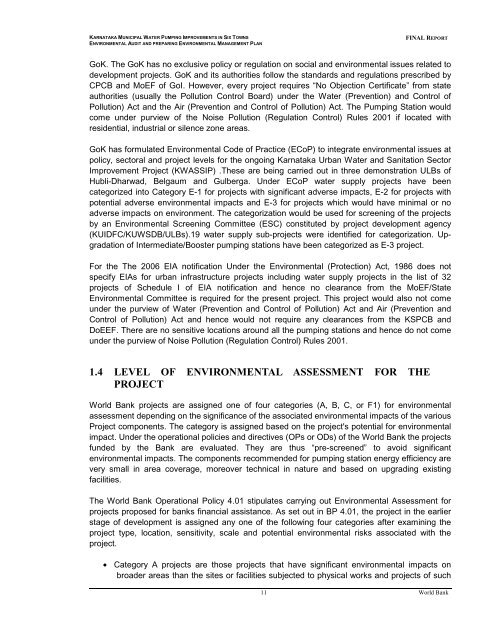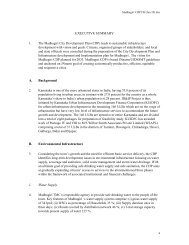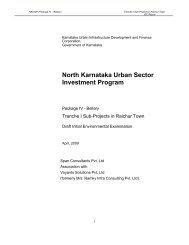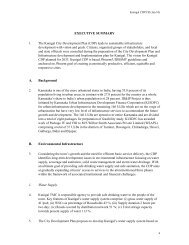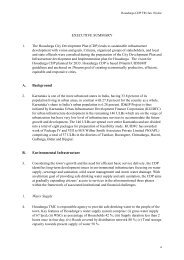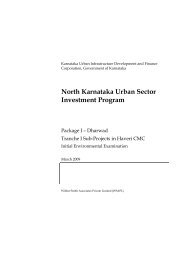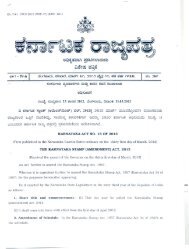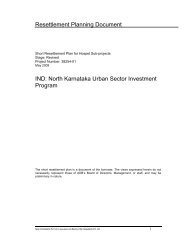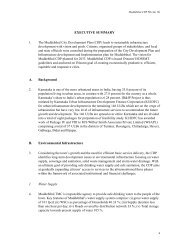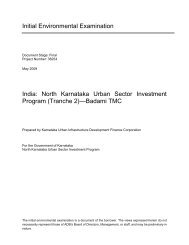KMWEEP-EA Final Report June 3 2008.pdf - kuidfc
KMWEEP-EA Final Report June 3 2008.pdf - kuidfc
KMWEEP-EA Final Report June 3 2008.pdf - kuidfc
You also want an ePaper? Increase the reach of your titles
YUMPU automatically turns print PDFs into web optimized ePapers that Google loves.
KARNATAKA MUNICIPAL WATER PUMPING IMPROVEMENTS IN SIX TOWNSENVIRONMENTAL AUDIT AND PREPARING ENVIRONMENTAL MANAGEMENT PLANFINAL REPORTGoK. The GoK has no exclusive policy or regulation on social and environmental issues related todevelopment projects. GoK and its authorities follow the standards and regulations prescribed byCPCB and MoEF of GoI. However, every project requires “No Objection Certificate” from stateauthorities (usually the Pollution Control Board) under the Water (Prevention) and Control ofPollution) Act and the Air (Prevention and Control of Pollution) Act. The Pumping Station wouldcome under purview of the Noise Pollution (Regulation Control) Rules 2001 if located withresidential, industrial or silence zone areas.GoK has formulated Environmental Code of Practice (ECoP) to integrate environmental issues atpolicy, sectoral and project levels for the ongoing Karnataka Urban Water and Sanitation SectorImprovement Project (KWASSIP) .These are being carried out in three demonstration ULBs ofHubli-Dharwad, Belgaum and Gulberga. Under ECoP water supply projects have beencategorized into Category E-1 for projects with significant adverse impacts, E-2 for projects withpotential adverse environmental impacts and E-3 for projects which would have minimal or noadverse impacts on environment. The categorization would be used for screening of the projectsby an Environmental Screening Committee (ESC) constituted by project development agency(KUIDFC/KUWSDB/ULBs).19 water supply sub-projects were identified for categorization. Upgradationof Intermediate/Booster pumping stations have been categorized as E-3 project.For the The 2006 EIA notification Under the Environmental (Protection) Act, 1986 does notspecify EIAs for urban infrastructure projects including water supply projects in the list of 32projects of Schedule I of EIA notification and hence no clearance from the MoEF/StateEnvironmental Committee is required for the present project. This project would also not comeunder the purview of Water (Prevention and Control of Pollution) Act and Air (Prevention andControl of Pollution) Act and hence would not require any clearances from the KSPCB andDoEEF. There are no sensitive locations around all the pumping stations and hence do not comeunder the purview of Noise Pollution (Regulation Control) Rules 2001.1.4 LEVEL OF ENVIRONMENTAL ASSESSMENT FOR THEPROJECTWorld Bank projects are assigned one of four categories (A, B, C, or F1) for environmentalassessment depending on the significance of the associated environmental impacts of the variousProject components. The category is assigned based on the project's potential for environmentalimpact. Under the operational policies and directives (OPs or ODs) of the World Bank the projectsfunded by the Bank are evaluated. They are thus “pre-screened” to avoid significantenvironmental impacts. The components recommended for pumping station energy efficiency arevery small in area coverage, moreover technical in nature and based on upgrading existingfacilities.The World Bank Operational Policy 4.01 stipulates carrying out Environmental Assessment forprojects proposed for banks financial assistance. As set out in BP 4.01, the project in the earlierstage of development is assigned any one of the following four categories after examining theproject type, location, sensitivity, scale and potential environmental risks associated with theproject.• Category A projects are those projects that have significant environmental impacts onbroader areas than the sites or facilities subjected to physical works and projects of such11 World Bank


